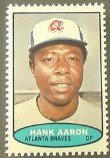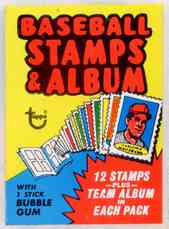Below are short bits & pieces on sportscard & baseball trading card collecting.
Please wander around the website for more info, prices, values & images
on vintage baseball, football, basketball, hockey, sport and non-sports cards.

Auction's most costly vintage baseball cards




The history of vintage baseball card auctions is long and colorful.
T-206 Honus Wagner tobacco cards have sold for upto $2.8 million in
auction. The "Holy Grail of Sports Cards", it's extreme-high auction
value can mostly be attributed to great PR and "auction fever".
It's not close to being the rarest baseball card and Honus Wagner is not
Babe Ruth or Mickey Mantle. Yes, the T-206 set is beautiful & special but
because of the # of cards and scarcities, few collector's try to complete,
which should keep auction competition down compared to say 1933 Goudey
or 1952 Topps baseball card issues.
BUT IT DOES NOT...
There's a story Wagner banned his card because he was anti-tobacco
but there are other stories about financial considerations.
You surely have heard of PSA and may even know that this card was the
FIRST they ever graded. But did you know that dealer (B.l. .ast.o name
encoded) admitted tampering with the card, perhaps having it trimmed
down to size, before PSA graded it so highly for the auction.
|

1971 Kellogg's
1971, Kellogg's second and by far scarcest and most valuable set,
contained 75 different players on 2 ¼” by 3 ½” cards.
The cards were plastic coated giving them a 3-D look !!!
The plastic coating also made high grade cards nearly impossible find.
Over time and the elements, most cards would curl making light and heavy
cracks very common.
As opposed to Kellogg's other issues which were available from the company as complete sets,
1971 Kellogg's cards were ONLY available one in each specially marked box of Kellogg's cereal.
The only way to complete your 1971 Kellogg's set was to pester mom to buy, buy, buy more boxes of cereal.
In addition to the 75 different players, numerous scarcer variations exist
with minor differences in the stats on back. In addition, all 75 cards and
some variations are found with 2 different forms of copyright on the back:
XOGRAPH ( 80 total cards)
@1970 XOGRAPH (121 total cards)
The numbers above may not be 100% accurate.
The "toughest" cards appear to be:
# 7 Alou (1970 Oakland NL)
# 28 Wright (Angles Crest Logo)
# 54 Johnson (Angles Crest Logo)
# 64 Fregosi (Angles Crest Logo)
# 70 Osteen (No Number on back)
# 2 Seaver (ERA 2.81)
# 41 Gaston (113 Runs)
# 65 Rose (RBI 485)
|



1974 Topps Stamps
Checklist & Values
1974 Topps Stamps set had (240) 1x1-1/2 inch stamps, 10/team.
Issued in 12-stamp panels in diff. combos of rows for
24 DIFFERENT panels in a complete 1974 Topps Stamps PANEL set.

NOTE: Your favorite may be on 2 different panels !!!
Set suffers from HORRIBLE centering and bad perforations.
1969/1974 Topps stamps are very similar except:
1974's oval vs 1969's banner.

1974 Topps Mini-Albums - seen - perhaps not released.
PACKED! Ryan, Aaron, Bench...
With Pete Rose and seldom seen Winfield & Parker rookies.
1974 Topps Baseball Stamps
1961 Topps Baseball Stamps
1962 Topps Baseball Stamps
1969 Topps Baseball Stamps
|

History Of O-Pee-Chee
O-Pee-Chee (OPC) based in Ontario Canada, is mostly thought of as the
Canadian version of Topps but it actually pre-dates Topps by many years.
In 1933, OPC issued their first sports card set, the V304 Hockey cards and
is currently in the tens of thousands. Their first baseball set was
issued in 1937. It was similar to the 1934 Goudeys and Batter-Ups
and the top player was Joe Dimaggio.
O-Pee-Chee created baseball card sets similar to TOpps from 1965 into the
1990's. At first OPC sets were much smaller than Topps
and included just the first few series. Fronts & backs were nearly identical
but with a small "Printed in Canada" on the back and the card stock was
slightly different.
Baseball being much less popular in Canada, OPC print runs of their early
years were between 1% and 10% of Topps making them exceedingly scarce !!!
Starting in 1970, Canadian legislation demanded all items produced in Canada
carry both French & English so OPC baseball cards became bilingual with both
languages included.
Other OPC differences include:
1971, OPC even changed the back design to a much more
interesting back and also offered 14 different card photos not in the Topps set.
1972 OPC included a card of Gil Hodges mentioning his death that was
not a part of the Topps set.
1974 OPC did not include any "Washington Nationals" variations.
1977 the card format remained like Topps but almost 1/3 of the OPC set had
different poses/images than Topps.
In late 1970's, OPC card fronts appeared similar to Topps but sometimes
included traded information saying "Now with XXXX". They were able to do
this as the OPC cards were printed much later into the season.
© 1995-2019 "InterNet's Baseball Card Store" / Joseph Juhasz ... All Rights Reserved
|




![1961 Post #179 Ernie Broglio [COM] (Cardinals) Baseball cards value](/jpgs/no-image.jpg)



